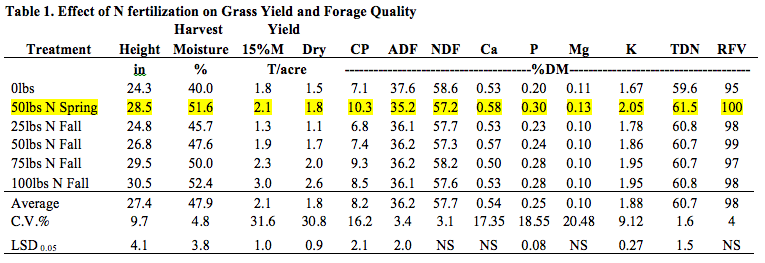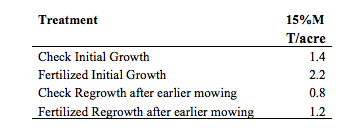Nitrogen application to improve yields and forage quality of perennial grasses.
This past season I have been getting several questions about options for increasing perennial forage production on their current land bases. The adoption of fertility management to tame pastures, non-legume hayland, and road ditches has been somewhat limited in this region. This study was conducted as a preliminary investigation to determine the potential for increasing yield and improving forage quality through nitrogen (N) fertility management. While this study was conduct several years ago, it is very relevant to the questions asked and I expect that the grasses species will respond to N fertilization in a similar way as reported here.
The study was conducted at the Carrington Research Extension Center, Carrington, ND. The site was a grass area that had not been fertilized for many years. The species composition of the site (around 80% Kentucky blue grass and around 20% smooth bromegrass) was typical of many pastures, non-legume hayland, and road ditches found around this region of the State. The N rates (0, 25, 50, 75, and 100 lbs/acre) were broadcast applied (as urea) on November 9, 2006 for the fall treatments and on April 17, 2007 for the spring treatment.
As fertilization rate increased, so did plant height and harvest moisture (Table 1). The 15% moisture (15%M) yield is equivalent to the yield/acre as a hay crop. There was no statistically significant difference for yield between the 50 lbs N Spring and the 50 lbs N, 75lbs N, and 100lbs N Fall rates. The crude protein (CP) was significantly higher for the 50lbs N Spring rate and the 75lbs N and 100lbs N Fall rates. The treatment with 50 lbs N/ac on spring showed no significant statistical difference for yield, CP and relative feed value (RFV) when compared to treatments with higher N rates. Therefore, the results lead to the conclusion that the application of 50lbs N/ac in the spring was the most economical treatment to increase both forage yield and forage quality. Based on experience over the years from numerous other trials, I would expect the same trend with the other cool season grass species. In addition, I would expect higher yields on stands with less Kentucky bluegrass and more Brome grasses and/or Wheat grasses.

A demonstration conducted by colleagues at the Center this growing season utilizing the US Highway 281 ditch just south of the main entrance. The stand is primarily smooth Bromegrass, intermediate wheatgrass, and switchgrass. A fertilizer blend containing N and P was broadcast early May with an N rate of 33lbs/acre. It was harvested July 12. Again, there is a response to fertilization with increased yields.

Therefore, if the economics permit, there is potential to increase both forage quantity and quality from existing, potentially overlooked, land resources.
Ezra Aberle
Agronomy Research Specialist


